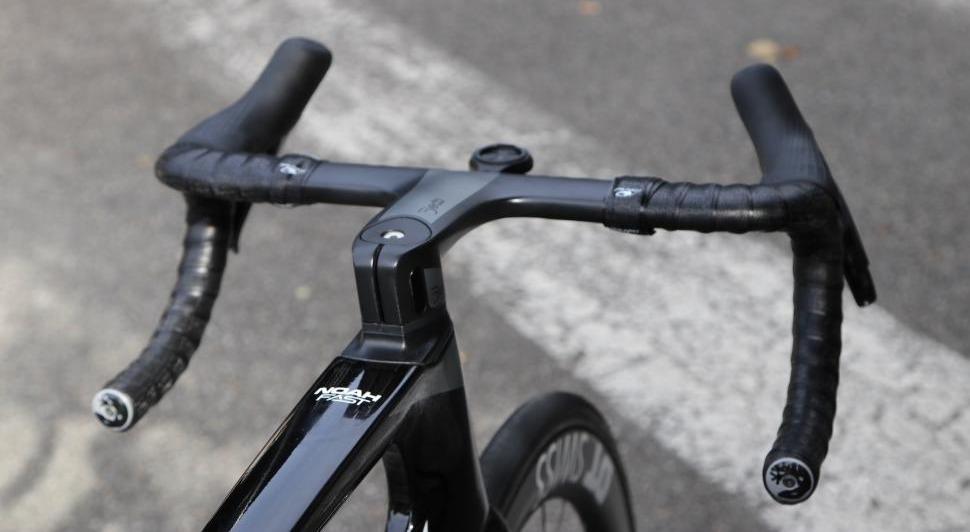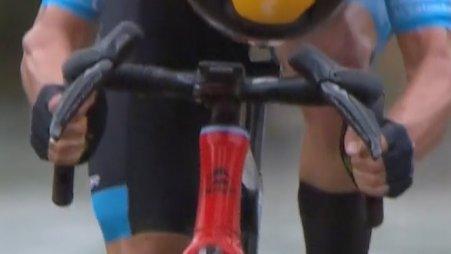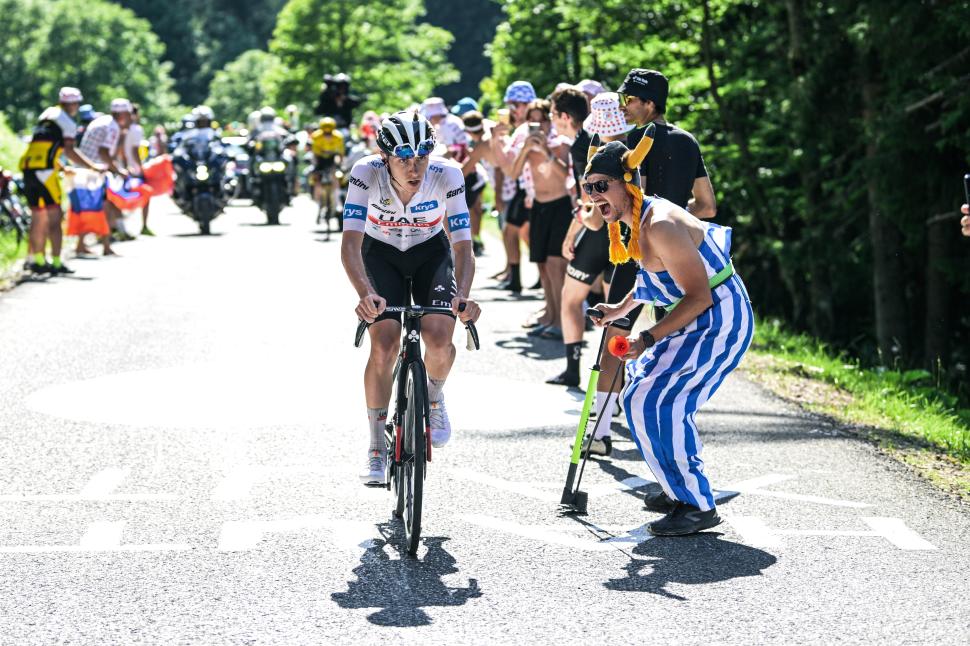- News
- Reviews
- Bikes
- Components
- Bar tape & grips
- Bottom brackets
- Brake & gear cables
- Brake & STI levers
- Brake pads & spares
- Brakes
- Cassettes & freewheels
- Chains
- Chainsets & chainrings
- Derailleurs - front
- Derailleurs - rear
- Forks
- Gear levers & shifters
- Groupsets
- Handlebars & extensions
- Headsets
- Hubs
- Inner tubes
- Pedals
- Quick releases & skewers
- Saddles
- Seatposts
- Stems
- Wheels
- Tyres
- Tubeless valves
- Accessories
- Accessories - misc
- Computer mounts
- Bags
- Bar ends
- Bike bags & cases
- Bottle cages
- Bottles
- Cameras
- Car racks
- Child seats
- Computers
- Glasses
- GPS units
- Helmets
- Lights - front
- Lights - rear
- Lights - sets
- Locks
- Mirrors
- Mudguards
- Racks
- Pumps & CO2 inflators
- Puncture kits
- Reflectives
- Smart watches
- Stands and racks
- Trailers
- Clothing
- Health, fitness and nutrition
- Tools and workshop
- Miscellaneous
- Buyers Guides
- Features
- Forum
- Recommends
- Podcast
TECH NEWS
 2022-dauphine-ridley-steff-cras levers bars
2022-dauphine-ridley-steff-cras levers bars UCI set to clamp down on “extreme” turned-in brake levers
The UCI’s decision to outlaw the aerodynamic ‘puppy paws’ position in 2021 has had some far reaching and unforeseen implications for world cycling’s governing body and its lawmakers, constantly kept on their toes by loophole-seeking, marginal gain hunting pros and their teams.
After banning riders from resting their forearms on the tops of their handlebars – the aero position de rigueur of the aero-hungry road racing rouleur – the UCI then, a year later, clamped down on the use of extremely narrow handlebars, the popularity of which had soared following the demise of the puppy paws position. And now, another year on, the governing body has stated its intention to restrict the use of another offshoot of that 2021 decision – the aggressively inward-facing brake lever.
In a statement released today as part of the UCI’s annual seminar in Lausanne for stakeholders of the men’s and women’s WorldTours, the governing body said it is currently working with the cycling industry to “create a clear regulation concerning the extreme inward inclination of brake levers”.
The sight of aggressively inverted brake levers – pioneered at the professional level by the ultra-narrow and boundary-pushing Dutchman Jan Willem Van Schip – has become an increasingly common one in the peloton in recent years, adopted by even Tadej Pogačar.
While the set-up has long been a controversial one, with some riders citing the safety implications of excessively turned-in levers, at the Tour Down Under in January the trend reached its aesthetically divisive zenith (or nadir, depending on your viewpoint), when Pello Bilbao rocked up in Australia with a handlebar set-up described by one viewer as “pre-crashed”.
Of course, the adoption of the inward brake lever look has little to do with style – according to most sources, for every 2cm closer together you bring your hands there’s a 25W advantage when travelling at 40km/h, a more than marginal gain for a rider like Pogačar trying to win the Tour de France.
However, the UCI says it will now clamp down on the peloton’s latest aero trend, which it believes could have serious safety implications for riders, with “restrictions” on handlebar set-up due to come into play as early as next season, before new regulations are formally introduced in 2025, when commissaires will be given a measuring tool to ensure that brake levers are in keeping with the manufacturer’s guidelines.
(A.S.O./Charly Lopez)
“Positioning the levers with an extreme inclination limits the braking capacity of the riders and constitutes a modification of the product beyond its intended use,” the UCI said today.
“Such positioning will be restricted in 2024. In 2025, new regulations will come into force requiring compliance with the installation guidelines established by brake lever manufacturers.”
> UCI clamps down on narrow handlebars, pin-less number pockets and support car trickery
As noted above, the latest restrictions come a year after the UCI’s initial attempt to halt the seemingly relentless march of super narrow road racing aero set-ups.
While Article 1.3.012 of the UCI’s technical regulations only previously stipulated that the maximum width of a bike, and therefore its handlebars, must not exceed 500mm, the updated rule, which came into force on 1 January 2023, now also states that “the minimum overall width (outside – outside) of traditional handlebars (road events) and base bars (road and track events) is limited to 350mm.”
While that particular rule change, due to the measurements stipulated, did not affect any existing set-ups, the UCI at least set out its stall when it comes to any further advancements in narrow bar technology, a position underlined by today’s brake lever announcement.
However, with the term “extreme” open to interpretation, it will be interesting to observe over the coming season how far cycling’s governing body is willing to go to clamp down on what it says is a serious safety concern in the peloton.
After obtaining a PhD, lecturing, and hosting a history podcast at Queen’s University Belfast, Ryan joined road.cc in December 2021 and since then has kept the site’s readers and listeners informed and enthralled (well at least occasionally) on news, the live blog, and the road.cc Podcast. After boarding a wrong bus at the world championships and ruining a good pair of jeans at the cyclocross, he now serves as road.cc’s senior news writer. Before his foray into cycling journalism, he wallowed in the equally pitiless world of academia, where he wrote a book about Victorian politics and droned on about cycling and bikes to classes of bored students (while taking every chance he could get to talk about cycling in print or on the radio). He can be found riding his bike very slowly around the narrow, scenic country lanes of Co. Down.
Latest Comments
- Mr Blackbird 12 min 29 sec ago
Depends how you ride them. The current trend among many pros is to ride in a track style looking down at the front wheel. Ok for racing on closed...
- Oldfatgit 2 hours 16 min ago
Are these actually 'hi-viz' - or just brights?...
- Bungle_52 2 hours 17 min ago
That one was completely different though, it was a driver not a car as in the other 3. So 1 in 4 of the stories manage to follow reporting guidelines.
- Rendel Harris 4 hours 10 min ago
Absolutely they could have. Tarmac is a petroleum-based product and its surface can be very oily when it's newly laid. This is particularly the...
- ROOTminus1 10 hours 12 min ago
I'm glad the article went into more detail and cleared things up, the headline had me worried that some autonomous building had run rampant and...
- mark1a 10 hours 30 min ago
Still here, just showing a few signs of wear and tear. Hopefully still serviceable for some years to come.
- Rendel Harris 11 hours 15 min ago
How can you know that you are "equally fearful" as "any female cyclist"? There is no possible way of quantifying such emotions and female cyclists...
- chrisonabike 11 hours 47 min ago
I think it would be fairer to blame the moon - as in "my client is a loony".
- Bungle_52 12 hours 10 min ago
Nice idea but Gloucestershire Constabulary are not interested as exemplified by this prvious NMOTD. Not only was there NFA for the close pass in...


Add new comment
15 comments
I've seen more crashes involving tri- bars than any other form of cockpit contact point out there. Ban tri bars then ? Remember Spinacci bars? Used widely in the pro peloton in the early 90's. UCI banned those, giving rise to the adoption of a puppy paws position that gave little control of the bars. Only took the UCI 30 years to ban that position too.
I'd like to know if there's any clear evidence that use of turned-in brake levers has caused crashes or is it that the UCI just doesn't like the look of them?
Common sense dictates it.
Brake levers were never designed to be used this way, at literally a 45 degree angle. You'd never be able to squeeze the levers as hard and going from the hoods to the drops quickly is compromised.
And having the tops of the hoods that close to each other means steering is compromised too.
It's puppy paws by stealth.
what is next..... ballast for bikes to slow leading riders down .....
Come again?
The only time I've seen such an absurd claim outside of this article is when I just now replicated the author's apparent research methods by googling "watts saved for narrow handlebars" and the first result was a random website claiming that "[m]ost estimates put the watt savings at 25 watts per 2cm of reduced handlebar width (at 40km/h)." No sources cited, of course, because there are none, because no one who knows what they're talking about would make such a claim.
The real number appears to be something more like 5 watts per 2cm at 45kph. It's more complicated than simply quoting a number, of course, because a whole host of complicating factors come into play--for example, is the rider negating the gains by sitting more upright because the narrower bars have reduced the bike's effective reach and he has failed to lengthen his stem to compensate?--but that's roughly the order of the potential effect size that we're dealing with.
At the risk of exposing my ignorance, but surely the angle and position of brake levers on hydraulic disk brakes is irrelevant?
The claim isn't that the performance of the braking system itself is affected, but rather that the rider's effective access to the levers is diminished.
(I don't buy the claim, necessarily; just explaining it.)
In fact, you are exposing your common sense. Completely irrelevant, just as you say.
Not necessarily irrelevant. Looking at the image in the article, the ability to apply and modulate braking is likely to be compromised. particularly when riding in the drops. The braking movement moves from the standard back and forth, to more of a side to side range.
Like all things, taken to extremis, it does have the potential to compromise safety.
and the problem is, if you are going to bring your levers in, why would you not bring them in as far as you can go?
And you also have to consider that for many, the intention is not to bring their hands in whilst on the drops, the intention is to get around the no puppy paws law.
I have got bikes with levers well turned in with rim and disc brakes. I don't race, I just want the least slowness possible from my dismal power. My intention is to get close to puppy paws position with more safety and control. It doesn't affect braking from the hoods in the slightest. I know you make it clear you are talking about extreme cases. But unless you turn them 90° and the levers hit the bars...I still think the UCI should prioritise, for example, safety in sprint arrivals first.
and is there any evidence for reduced braking performance or is this just that they don't like the look or dont want kids emulating such a dangerous idea ( the reason cited for nbanning the puppy hands position)
25w for every 2cm the hands are closer together? I've got about 20cms between hands on the hoods and hands gripping either side of the stem, old-school climber style, moving from outside to in is going to give me 250w at 40km/h?!
Yep, I'd suggest the quoted numbers are innaccurate.
More likely, for every two centimetres that you bring your arms in, you will save 25w. And that refers to the whole arm. The limitation of course being the width of the shoulder.
25w per cm advantage? I am struggling to believe that even if it's true!
25W per cm would be ridiculous. It's 25W per 2cm.